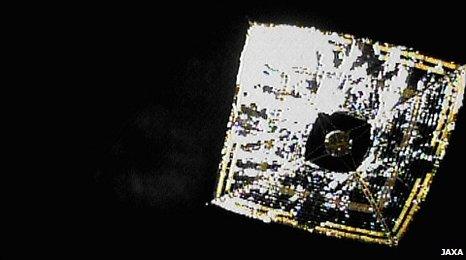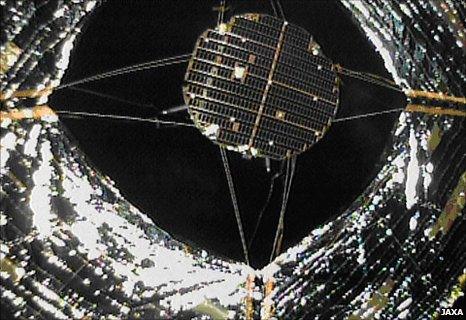Mini-camera pictures Japan's Ikaros solar sail
- Published

The sail has an area of about 200 square metres
It is the picture that confirms Japan's Ikaros solar sail is fully extended and ready for the next part of its mission.
The image was acquired by a tiny camera ejected from the central hub of Ikaros.
It transmitted the picture back to the central hub of the spacecraft, which then relayed the data many millions of kilometres to Earth.
Ikaros will demonstrate the principle of solar sailing, which has long been touted as a means of moving spacecraft around the Solar System.
The pressure of sunlight alone should drive the hub and its membrane through space.
Japanese space agency (Jaxa) scientists want to detect a measurable acceleration in the spacecraft as photons - the particles of light - from the Sun fall on the roughly 200-sq-m, ultra-thin sheet.
They will also attempt to change the direction of Ikaros by altering the angle of the sail. There are thrusters in the hub to do this, but the researchers want to see if it is possible simply by adjusting the reflectivity of LCDs embedded in the sail.
Ikaros was launched as a piggy-back mission to Japan's Akatsuki Venus orbiter on 20 May (GMT). Akatsuki should get to Venus in December. Ikaros on the other hand will push on past the planet.
Solar sailing has been talked about for many years. The science fiction author and futurologist Sir Arthur C Clarke even wrote about solar yachts racing around the Moon.
And although Ikaros represents the first large-scale demonstration of a sail, some conventional satellites already use reflective flaps to maintain their orbits more efficiently.
There are still many challenges ahead for Ikaros.
The project team will be particularly concerned to keep the sail fully extended and flat.
Rather than employ rigid booms or ribs to do this, Ikaros simply spins, making one or two revolutions per minute.
But other solar sail scientists say that if instabilities develop in this type of design, Ikaros could start to fold in on itself.

The central hub relayed the pictures back to Earth
It has been a busy period for Jaxa. On Sunday, its Hayabusa mission to retrieve samples from asteroid Itokawa returned to Earth.
- Published21 May 2010
- Published11 June 2010